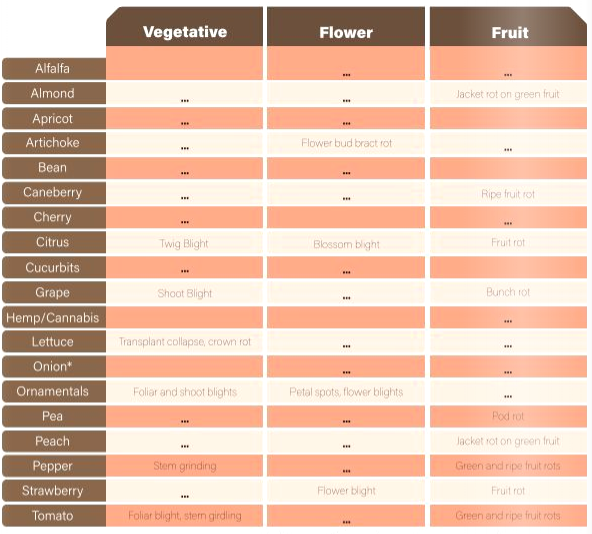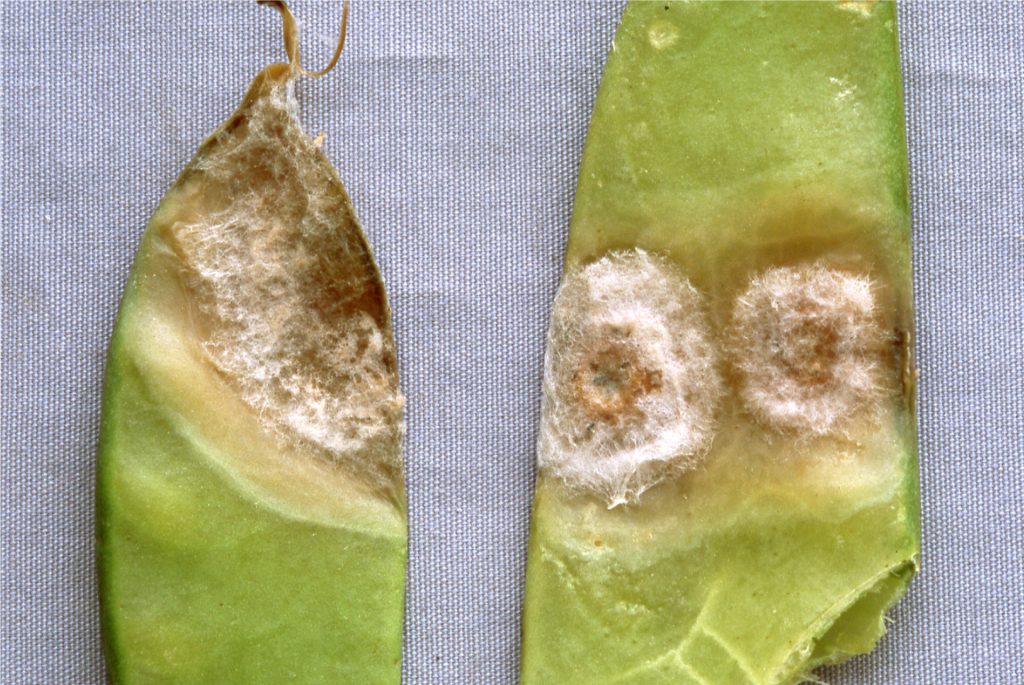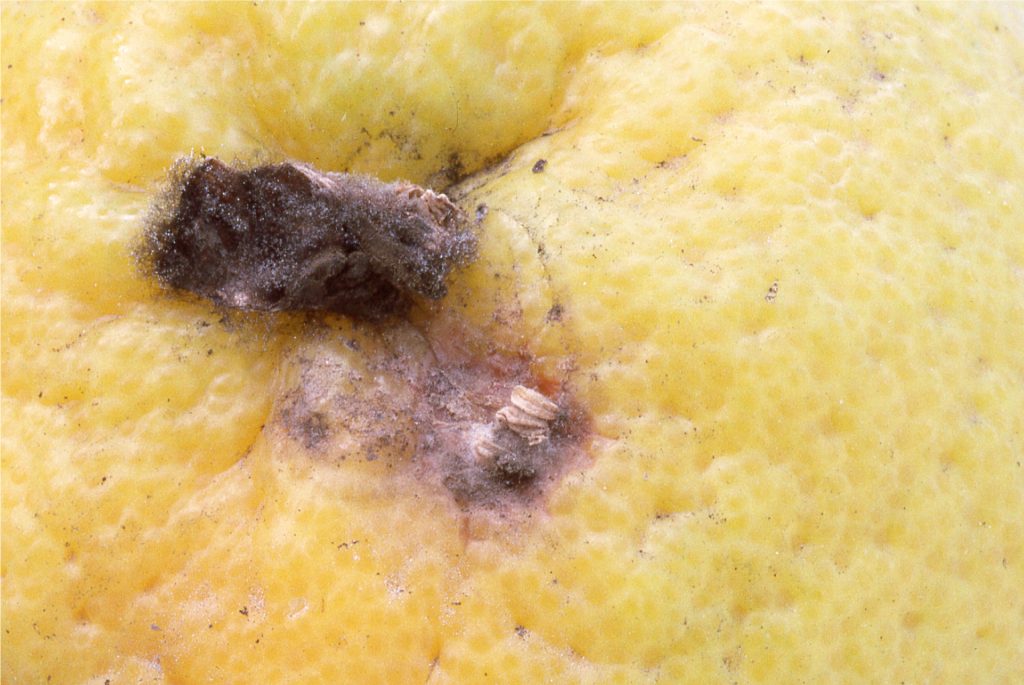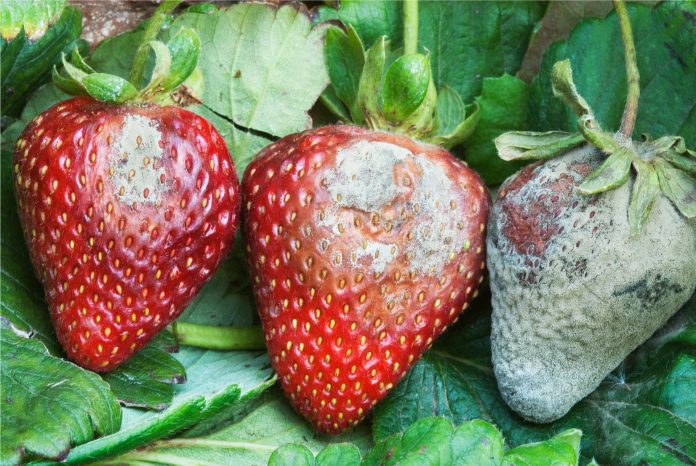Introduction and Significance
When evaluating the impact and importance of a plant pathogen, one could consult various metrics to make such an assessment. One could consider the values of the affected crops, the acreages planted, the geographic distribution (how widespread is it?) of the pathogen, the mode of pathogen attack (does it affect leaves, flowers, both?), the persistence and staying-power of the organism, and the difficulty in controlling the pathogen. The Botrytis fungus, causal agent of gray mold and other related diseases, is one of the few plant pathogens that could arguably be placed at or near the top of a key pathogen list based on all of these criteria. Field professionals likely are familiar with the challenges of gray mold for the crops they oversee. However, what may be overlooked is the impact of Botrytis throughout a broad spectrum of many agricultural commodities and settings. Botrytis is an unusually dangerous threat due to its ability to infect dozens of crops, uncommon versatility as a microorganism, and propensity to change genetically in adapting to fungicide chemistry.

*In contrast to most other crops diseases on onion are not primarily caused by Botrytis cinerea but by other Botrytis species.
Broad Spectrum Impact on Crops Worldwide
Botrytis is a highly ranked plant pathogen due to its broad host range that includes hundreds of plants. Such hosts are in almost all commodity groups: annuals and perennials, herbaceous and woody plants, food and ornamental crops, vegetable and fruit and field crops. Included within this diverse list are dozens of high value vegetable, fruit, and ornamental commodities (examples are listed in Table 1 and seen in Photos 1 to 4), for which gray mold can inflict sizeable economic losses. This broad spectrum of activity can also be described based on the type of plant tissue affected. Depending on the crop host, Botrytis can infect the vegetative portions (stems, petioles, leaves), flowering parts (buds, sepals, petals, reproductive tissues), and fruit (immature and ripe phases).
The Botrytis impact on all these crops and commodity groups is further compounded by two factors. First, the gray mold fungus can cause significant disease both before and after harvest. Pre-harvest disease occurs when Botrytis is active on developing plants in the field and greenhouse, resulting in blight, decay, and rot that reduces crop quality and harvestability. In addition, for many crops the Botrytis fungus can be a contaminant on or even inside the harvested plant commodity. Once these contaminated commodities are stored, the Botrytis fungus can become activated under certain postharvest conditions and cause rots and decay in storage (Photo 5). Secondly, we note that Botrytis is found throughout most agricultural and horticultural production regions in the world. In the USA, there are only a few states where an official report of Botrytis is lacking. Likewise, Botrytis is found throughout the world and is reported to cause disease on a huge number of crops and plants.

Versatility as a Microorganism
A notable feature about Botrytis is the organism’s ability to function in different modes or survival strategies. This diversity of biological activity is not commonly seen in plant pathogens and points to the extreme versatility of Botrytis as a microorganism. Pathogen: We are most aware of Botrytis as an aggressive, difficult to control primary pathogen of plants. From an agricultural point of view, this is the most prominent role for Botrytis. Saprophyte: In a different mode, Botrytis does not even need a living plant. As a saprophyte, the gray mold fungus can grow, thrive, and reproduce on senescent, dying, and dead organic plant tissue. Spores that land on decaying matter can readily germinate and colonize such substrates. Secondary invader: If a plant is injured from weather extremes, damaged from mishaps in the field, or has symptoms caused by other pathogens, spores of Botrytis can drop onto such compromised plant tissues and aggressively grow on and overwhelm the injured plant. In such situations Botrytis did not initially cause the problem but is a secondary invader that can make the overall problem worse.
Dormant sleeper: Botrytis can be a sneaky adversary. This pathogen can infect and penetrate plant tissues but remain dormant within the protection of its host. Later, when the conditions change, the weather warms, or the plant tissues mature and grow, the once dormant Botrytis wakes up and begins to colonize the host, resulting in gray mold disease. Such dormant infections are called latent or “quiescent” infections. Opportunist: Botrytis is an opportunist because it can switch from being a harmless saprophyte, growing on dead tissue that growers do not care about, to an aggressive pathogen causing problems. Numerous examples exist of this switching. The Botrytis starts by colonizing dead parts of plants, such as old flower parts; if these Botrytis-laden dead pieces are in contact with healthy tissue, the Botrytis is able to bridge over from the dead to the living, resulting in a primary disease problem (Photo 6).
Gray mold is also versatile in how it survives and is moved around in the agricultural environment. Airborne spores: The gray color of the fungus, as it appears on infected plants, indicates Botrytis is producing millions of spores. These spore masses (Photo 7) are readily spread long distances by winds, splashing water, and physical contact. Sclerotia: Under certain conditions Botrytis can produce a survival structure, the sclerotium, which is a hard, black, oblong to spherical structure that can be up to ½ inch long. Sclerotia can withstand dry, warm, or cold conditions and can survive inside dead crop debris or buried in the soil; under conducive conditions these sclerotia can germinate and produce mycelium that infects the host. Sclerotia can form within the hollow stems of plant hosts and be carried with the plant if these stems are moved to other locations. Sclerotia can become mixed in with seed and become a seedborne contaminant. Embedded mycelium: In another survival mode, the hyphal strands of Botrytis can penetrate and be buried inside the living flowers, buds, or stems of plant hosts. This strategy allows the gray mold fungus to be protected from harsh environmental conditions, giving it an opportunity to wait for more favorable situations.

Genetic Plasticity and Loss of Fungicide Efficacy
Botrytis is notorious for becoming resistant (insensitive) to fungicides because of its high genetic variability and adaptability, profuse production of spores, and multiple cycles of spore production. Molecular recombination, mixing of genes between strains, and mutations provide the raw genetic material for resistance to develop. When fungicides are applied numerous times to a susceptible crop, the presence of the chemical challenges Botrytis and can result in the selection of individual strains that are no longer affected by that chemistry. Fungicides with single-site modes of action are especially at risk for inducing resistance in Botrytis. Worldwide, resistant isolates of Botrytis have been confirmed for all of the single-site fungicide categories used to manage gray mold (Table 2). Even more alarming are the research findings that show individual isolates of Botrytis can possess resistance to multiple fungicide classes; there are even isolates that are shown to be resistant to seven different fungicides, each of which has a different mode of action.

A Note About Botrytis Species
This article is addressing the broad topic of gray mold caused by Botrytis, and for most crops the pathogen species is Botrytis cinerea. However, examining the DNA of Botrytis from different crops in different parts of the world, powerful molecular tools and innovative techniques are detecting multiple, diverse genetic signatures which indicate that B. cinerea is not the only gray mold species out there. For example, a series of studies documents that strawberry can be infected by one or more of the following Botrytis species: B. cinerea, B. fragariae, B. caroliniana, B. mali, B. pseudocinerea. Such findings can have implications for the farmer and the field. On grapes in France, for example, the B. pseudocinerea species is more active in the early spring, while B. cinerea is active in both spring and fall. There are indications that a higher percentage of B. pseudocinerea isolates are resistant to some fungicides than B. cinerea isolates. So in the future it might be critical to know exactly which species is causing gray mold, since different species may require slightly different management approaches.
Management of Gray Mold
Controlling gray mold diseases requires the implementation of IPM practices. Fungicides: Judicious and strategic use of fungicides remains the primary means of managing gray mold. Multiple applications usually are needed, throughout the season, using diverse products having different modes of action. Fungicides with single-site modes of action are especially at risk for inducing resistance in Botrytis, so multi-site products should be integrated into spray programs. Sanitation: Sanitation measures, such as the removal of dead leaves and diseased fruit, appear to only slightly decrease gray mold incidence and cannot replace reliance on fungicide programs. Given the logistical difficulty and expense of such measures, these sanitation steps are not practical for most commercial growers but could be a consideration in certain circumstances, such as for greenhouse crop production.

Modifying the environment: Because Botrytis is dependent on free moisture and high humidity, reducing such factors can help reduce disease severity. The venting out of moist air in a greenhouse is one example of such environmental modifications. Use of drip irrigation is a field equivalent of reducing water on foliage and can reduce gray mold severity. Canopy modification (pruning to remove leaves and laterals and increase air flow and light penetration) can help with bunch rot control in grapes. Resistant or tolerant cultivars: For most crops there are no cultivars that are genetically resistant to Botrytis. However, some cultivars may experience less gray mold for other reasons. For example, some strawberry cultivars suffer less gray mold due to the upright growth habit of leaves and flowers. Use such cultivars if available. Reduce damage: Reducing damage to crops in the field will reduce the opportunities for Botrytis to invade as a secondary decay organism. Proper harvesting and postharvest handling of fruit are critical to reducing fruit injury and lowering the impact from gray mold. Storing fruit at low temperatures is also necessary to retard gray mold and slow down the aging and senescing of fruit.






















[…] Botrytis can persist as latent infections in plant tissue, reactivating when conditions improve Latent infections. A rainfast product can help reduce the risk by creating a barrier that prevents spores from […]